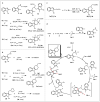Modular assembly of indole alkaloids enabled by multicomponent reaction
- PMID: 37558669
- PMCID: PMC10412628
- DOI: 10.1038/s41467-023-40598-y
Modular assembly of indole alkaloids enabled by multicomponent reaction
Abstract
Indole alkaloids are one of the largest alkaloid classes, proving valuable structural moiety in pharmaceuticals. Although methods for the synthesis of indole alkaloids are constantly explored, the direct single-step synthesis of these chemical entities with broad structural diversity remains a formidable challenge. Herein, we report a modular assembly of tetrahydrocarboline type of indole alkaloids from simple building blocks in a single step while showing broad compatibility with medicinally relevant functionality. In this protocol, the 2-alkylated or 3-alkylated indoles, formaldehyde, and amine hydrochlorides could undergo a one-pot reaction to deliver γ-tetrahydrocarbolines or β-tetrahydrocarbolines directly. A wide scope of these readily available starting materials is applicable in this process, and numerous structural divergent tetrahydrocarbolines could be achieved rapidly. The control reaction and deuterium-labelling reaction are conducted to probe the mechanism. And mechanistically, this multicomponent reaction relies on a multiple alkylamination cascade wherein an unusual C(sp3)-C(sp3) connection was involved in this process. This method could render rapid access to pharmaceutically interesting compounds, greatly enlarge the indole alkaloid library and accelerate the lead compound optimization thus facilitating drug discovery.
© 2023. Springer Nature Limited.
Conflict of interest statement
The authors declare no competing interests.
Figures






Similar articles
-
A multicomponent reaction for modular assembly of indole-fused heterocycles.Chem Sci. 2024 Mar 4;15(14):5211-5217. doi: 10.1039/d4sc00522h. eCollection 2024 Apr 3. Chem Sci. 2024. PMID: 38577354 Free PMC article.
-
Intramolecular dearomative oxidative coupling of indoles: a unified strategy for the total synthesis of indoline alkaloids.Acc Chem Res. 2015 Mar 17;48(3):702-11. doi: 10.1021/ar5004303. Epub 2015 Feb 10. Acc Chem Res. 2015. PMID: 25667972
-
Indole Alkaloid Synthesis Facilitated by Photoredox Catalytic Radical Cascade Reactions.Acc Chem Res. 2019 Jul 16;52(7):1877-1891. doi: 10.1021/acs.accounts.9b00246. Epub 2019 Jul 2. Acc Chem Res. 2019. PMID: 31264824
-
Harnessing the Chemistry of the Indole Heterocycle to Drive Discoveries in Biology and Medicine.Chembiochem. 2019 Sep 16;20(18):2273-2297. doi: 10.1002/cbic.201800768. Epub 2019 Jul 17. Chembiochem. 2019. PMID: 30609199 Review.
-
The Molecular Diversity of 1H-Indole-3-Carbaldehyde Derivatives and Their Role in Multicomponent Reactions.Top Curr Chem (Cham). 2022 Apr 25;380(4):24. doi: 10.1007/s41061-022-00379-5. Top Curr Chem (Cham). 2022. PMID: 35467226 Review.
Cited by
-
Multiomic Analysis Provided Insights into the Responses of Carbon Sources by Wood-Rotting Fungi Daldinia carpinicola.J Fungi (Basel). 2025 Feb 4;11(2):115. doi: 10.3390/jof11020115. J Fungi (Basel). 2025. PMID: 39997409 Free PMC article.
-
Multicomponent reactions (MCRs) yielding medicinally relevant rings: a recent update and chemical space analysis of the scaffolds.RSC Adv. 2025 Jan 16;15(2):1447-1489. doi: 10.1039/d4ra06681b. eCollection 2025 Jan 9. RSC Adv. 2025. PMID: 39822567 Free PMC article. Review.
-
A multicomponent reaction for modular assembly of indole-fused heterocycles.Chem Sci. 2024 Mar 4;15(14):5211-5217. doi: 10.1039/d4sc00522h. eCollection 2024 Apr 3. Chem Sci. 2024. PMID: 38577354 Free PMC article.
References
Grants and funding
LinkOut - more resources
Full Text Sources
Other Literature Sources

